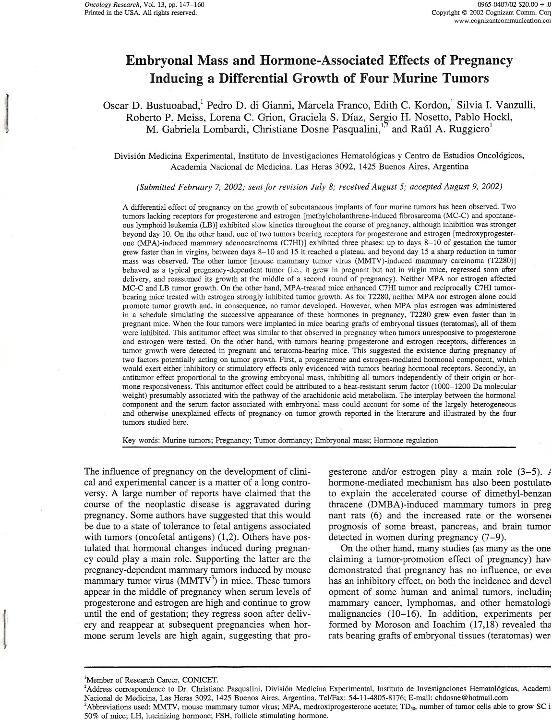Artículo
Embryonal mass and hormone-associated effects of pregnancy inducing a differential growth of four murine tumors
Bustuoabad, Oscar David ; di Gianni, Pedro D.; Franco, Marcela; Kordon, Edith Claudia
; di Gianni, Pedro D.; Franco, Marcela; Kordon, Edith Claudia ; Vanzulli, Silvia I.; Meiss, Roberto P.; Grion, Lorena C.; Diaz, Graciela Susana
; Vanzulli, Silvia I.; Meiss, Roberto P.; Grion, Lorena C.; Diaz, Graciela Susana ; Nosetto, Sergio H.; Hockl, Pablo Francisco
; Nosetto, Sergio H.; Hockl, Pablo Francisco ; Lombardi, María Gabriela
; Lombardi, María Gabriela ; Pasqualini, Christiane Dosne; Ruggiero, Raul Alejandro
; Pasqualini, Christiane Dosne; Ruggiero, Raul Alejandro
 ; di Gianni, Pedro D.; Franco, Marcela; Kordon, Edith Claudia
; di Gianni, Pedro D.; Franco, Marcela; Kordon, Edith Claudia ; Vanzulli, Silvia I.; Meiss, Roberto P.; Grion, Lorena C.; Diaz, Graciela Susana
; Vanzulli, Silvia I.; Meiss, Roberto P.; Grion, Lorena C.; Diaz, Graciela Susana ; Nosetto, Sergio H.; Hockl, Pablo Francisco
; Nosetto, Sergio H.; Hockl, Pablo Francisco ; Lombardi, María Gabriela
; Lombardi, María Gabriela ; Pasqualini, Christiane Dosne; Ruggiero, Raul Alejandro
; Pasqualini, Christiane Dosne; Ruggiero, Raul Alejandro
Fecha de publicación:
01/2002
Editorial:
Cognizant Communication Corp
Revista:
Oncology Research
ISSN:
0965-0407
Idioma:
Inglés
Tipo de recurso:
Artículo publicado
Clasificación temática:
Resumen
A differential effect of pregnancy on the growth of subcutaneous implants of four murine tumors has been observed. Two tumors lacking receptors for progesterone and estrogen [methylcholanthrene-induced fibrosarcoma (MC-C) and spontaneous lymphoid leukemia (LB)] exhibited slow kinetics throughout the course of pregnancy, although inhibition was stronger beyond day 10. On the other hand, one of two tumors bearing receptors for progesterone and estrogen [medroxyprogesterone (MPA)-induced mammary adenocarcinoma (C7HI)] exhibited three phases: up to days 8-10 of gestation the tumor grew faster than in virgins, between days 8-10 and 15 it reached a plateau, and beyond day 15 a sharp reduction in tumor mass was observed. The other tumor [mouse mammary tumor virus (MMTV)-induced mammary carcinoma(T2280)] behaved as a typical pregnancy-dependent tumor (i.e., it grew in pregnant but not in virgin mice, regressed soon after delivery, and reassumed its growth at the middle of a second round of pregnancy). Neither MPA nor estrogen affected MC-C and LB tumor growth. On the other hand, MPA-treated mice enhanced C7HI tumor and reciprocally C7HI tumor-bearing mice treated with estrogen strongly inhibited tumor growth. As for T2280, neither MPA nor estrogen alone could promote tumor growth and, in consequence, no tumor developed. However, when MPA plus estrogen was administered in a schedule simulating the successive appearance of these hormones in pregnancy, T2280 grew even faster than in pregnant mice. When the four tumors were implanted in mice bearing grafts of embryonal tissues (teratomas), all of them were inhibited. This antitumor effect was similar to that observed in pregnancy when tumors unresponsive to progesterone and estrogen were tested. On the other hand, with tumors bearing progesterone and estrogen receptors, differences in tumor growth were detected in pregnant and teratoma-bearing mice. This suggested the existence during pregnancy of two factors potentially acting on tumor growth. First, a progesterone and estrogen-mediated hormonal component, which would exert either inhibitory or stimulatory effects only evidenced with tumors bearing hormonal receptors. Secondly, an antitumor effect proportional to the growing embryonal mass, inhibiting all tumors independently of their origin or hormone responsiveness. This antitumor effect could be attributed to a beat-resistant serum factor (1,000-1,200 Da molecular weight) presumably associated with the pathway of the arachidonic acid metabolism. The interplay between the hormonal component and the serum factor associated with embryonal mass could account for some of the largely heterogeneous and otherwise unexplained effects of pregnancy on tumor growth reported in the literature and illustrated by the four tumors studied here.
Palabras clave:
Tnfa
,
Lif
,
Erk
,
Mammary Involution
,
Murine Tumors
,
Pregnancy
,
Hormone Regulation
Archivos asociados
Licencia
Identificadores
Colecciones
Articulos(IBYME)
Articulos de INST.DE BIOLOGIA Y MEDICINA EXPERIMENTAL (I)
Articulos de INST.DE BIOLOGIA Y MEDICINA EXPERIMENTAL (I)
Articulos(IFIBYNE)
Articulos de INST.DE FISIOL., BIOL.MOLECULAR Y NEUROCIENCIAS
Articulos de INST.DE FISIOL., BIOL.MOLECULAR Y NEUROCIENCIAS
Articulos(IMEX)
Articulos de INST.DE MEDICINA EXPERIMENTAL
Articulos de INST.DE MEDICINA EXPERIMENTAL
Citación
Bustuoabad, Oscar David; di Gianni, Pedro D.; Franco, Marcela; Kordon, Edith Claudia; Vanzulli, Silvia I.; et al.; Embryonal mass and hormone-associated effects of pregnancy inducing a differential growth of four murine tumors; Cognizant Communication Corp; Oncology Research; 1-2002; 147-160
Compartir



